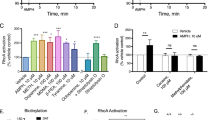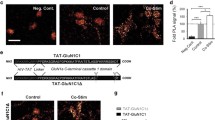Abstract
The dopamine transporter (DAT) is an important regulator of brain dopamine (DA) homeostasis, controlling the intensity and duration of DA signaling. DAT is the target for psychostimulants—like cocaine and amphetamine—and plays an important role in neuropsychiatric disorders, including attention-deficit hyperactivity disorder and drug addiction. Thus, a thorough understanding of the mechanisms that regulate DAT function is necessary for the development of clinical interventions to treat DA-related brain disorders. Previous studies have revealed a plethora of protein–protein interactions influencing DAT cellular localization and activity, suggesting that the fine-tuning of DA homeostasis involves multiple mechanisms. We recently reported that G-protein beta-gamma (Gβγ) subunits bind directly to DAT and decrease DA clearance. Here we show that Gβγ induces the release of DA through DAT. Specifically, a Gβγ-binding/activating peptide, mSIRK, increases DA efflux through DAT in heterologous cells and primary dopaminergic neurons in culture. Addition of the Gβγ inhibitor gallein or DAT inhibitors prevents this effect. Residues 582 to 596 in the DAT carboxy terminus were identified as the primary binding site of Gβγ. A TAT peptide containing the Gβγ-interacting domain of DAT blocked the ability of mSIRK to induce DA efflux, consistent with a direct interaction of Gβγ with the transporter. Finally, activation of a G-protein-coupled receptor, the muscarinic M5R, results in DAT-mediated DA efflux through a Gβγ-dependent mechanism. Collectively, our data show that Gβγ interacts with DAT to promote DA efflux. This novel mechanism may have important implications in the regulation of brain DA homeostasis.





Similar content being viewed by others
References
Torres GE, Gainetdinov RR, Caron MG . Plasma membrane monoamine transporters: structure, regulation and function. Nat Rev Neurosci 2003; 4: 13–25.
Cragg SJ, Rice ME . DAncing past the DAT at a DA synapse. Trends Neurosci 2004; 27: 270–277.
Giros B, Caron MG . Molecular characterization of the dopamine transporter. Trends Pharmacol Sci 1993; 14: 43–49.
Sulzer D, Sonders MS, Poulsen NW, Galli A . Mechanisms of neurotransmitter release by amphetamines: a review. Prog Neurobiol 2005; 75: 406–433.
Robbins TW, Everitt BJ . Drug addiction: bad habits add up. Nature 1999; 398: 567–570.
Amara SG, Sonders MS . Neurotransmitter transporters as molecular targets for addictive drugs. Drug Alcohol Depend 1998; 51: 87–96.
Sager JJ, Torres GE . Proteins interacting with monoamine transporters: current state and future challenges. Biochemistry 2011; 50: 7295–7310.
Steinkellner T, Yang JW, Montgomery TR, Chen WQ, Winkler MT, Sucic S et al. Ca(2+)/calmodulin-dependent protein kinase IIalpha (alphaCaMKII) controls the activity of the dopamine transporter: implications for Angelman syndrome. J Biol Chem 2012; 287: 29627–29635.
Cervinski MA, Foster JD, Vaughan RA . Psychoactive substrates stimulate dopamine transporter phosphorylation and down-regulation by cocaine-sensitive and protein kinase C-dependent mechanisms. J Biol Chem 2005; 280: 40442–40449.
Garcia-Olivares J, Torres-Salazar D, Owens WA, Baust T, Siderovski DP, Amara SG et al. Inhibition of dopamine transporter activity by G protein betagamma subunits. PLoS ONE 2013; 8: e59788.
Leviel V . Dopamine release mediated by the dopamine transporter, facts and consequences. J Neurochem 2011; 118: 475–489.
Rice ME, Patel JC . Somatodendritic dopamine release: recent mechanistic insights. Philos Trans R Soc Lond B Biol Sci 2015; 370: 1–14.
Sitte HH, Freissmuth M . Amphetamines, new psychoactive drugs and the monoamine transporter cycle. Trends Pharmacol Sci 2015; 36: 41–50.
Hamilton PJ, Belovich AN, Khelashvili G, Saunders C, Erreger K, Javitch JA et al. PIP2 regulates psychostimulant behaviors through its interaction with a membrane protein. Nat Chem Biol 2014; 10: 582–589.
Goubaeva F, Ghosh M, Malik S, Yang J, Hinkle PM, Griendling KK et al. Stimulation of cellular signaling and G protein subunit dissociation by G protein betagamma subunit-binding peptides. J Biol Chem 2003; 278: 19634–19641.
Stott JB, Povstyan OV, Carr G, Barrese V, Greenwood IA . G-protein betagamma subunits are positive regulators of Kv7.4 and native vascular Kv7 channel activity. Proc Natl Acad Sci USA 2015; 112: 6497–6502.
Wang YF, Hatton GI . Dominant role of betagamma subunits of G-proteins in oxytocin-evoked burst firing. J Neurosci 2007; 27: 1902–1912.
Lehmann DM, Seneviratne AM, Smrcka AV . Small molecule disruption of G protein beta gamma subunit signaling inhibits neutrophil chemotaxis and inflammation. Mol Pharmacol 2008; 73: 410–418.
Scott JK, Huang SF, Gangadhar BP, Samoriski GM, Clapp P, Gross RA et al. Evidence that a protein-protein interaction 'hot spot' on heterotrimeric G protein betagamma subunits is used for recognition of a subclass of effectors. EMBO J 2001; 20: 767–776.
Krapivinsky G, Kennedy ME, Nemec J, Medina I, Krapivinsky L, Clapham DE . Gbeta binding to GIRK4 subunit is critical for G protein-gated K+ channel activation. J Biol Chem 1998; 273: 16946–16952.
Lin Y, Smrcka AV . Understanding Molecular Recognition by G protein {beta}{gamma} Subunits on the Path to Pharmacological Targeting. Mol Pharmacol 2011; 10: 1124, /mol.111.073072.
Opazo F, Schulz JB, Falkenburger BH . PKC links Gq-coupled receptors to DAT-mediated dopamine release. J Neurochem 2010; 114: 587–596.
Giros B, Jaber M, Jones SR, Wightman RM, Caron MG . Hyperlocomotion and indifference to cocaine and amphetamine in mice lacking the dopamine transporter. Nature 1996; 379: 606–612.
Sulzer D . How addictive drugs disrupt presynaptic dopamine neurotransmission. Neuron 2011; 69: 628–649.
Attwell D, Barbour B, Szatkowski M . Nonvesicular release of neurotransmitter. Neuron 1993; 11: 401–407.
Schmitt KC, Rothman RB, Reith ME . Nonclassical pharmacology of the dopamine transporter: atypical inhibitors, allosteric modulators, and partial substrates. J Pharmacol Exp Ther 2013; 346: 2–10.
Fischer JF, Cho AK . Chemical release of dopamine from striatal homogenates: evidence for an exchange diffusion model. J Pharmacol Exp Ther 1979; 208: 203–209.
Pifl C, Singer EA . Ion dependence of carrier-mediated release in dopamine or norepinephrine transporter-transfected cells questions the hypothesis of facilitated exchange diffusion. Mol Pharmacol 1999; 56: 1047–1054.
Sitte HH, Huck S, Reither H, Boehm S, Singer EA, Pifl C . Carrier-mediated release, transport rates, and charge transfer induced by amphetamine, tyramine, and dopamine in mammalian cells transfected with the human dopamine transporter. J Neurochem 1998; 71: 1289–1297.
Kahlig KM, Binda F, Khoshbouei H, Blakely RD, McMahon DG, Javitch JA et al. Amphetamine induces dopamine efflux through a dopamine transporter channel. Proc Natl Acad Sci USA 2005; 102: 3495–3500.
Khoshbouei H, Wang H, Lechleiter JD, Javitch JA, Galli A . Amphetamine-induced dopamine efflux. A voltage-sensitive and intracellular Na+-dependent mechanism. J Biol Chem 2003; 278: 12070–12077.
Khoshbouei H, Sen N, Guptaroy B, Johnson L, Lund D, Gnegy ME et al. N-terminal phosphorylation of the dopamine transporter is required for amphetamine-induced efflux. PLoS Biol 2004; 2: E78.
Fog JU, Khoshbouei H, Holy M, Owens WA, Vaegter CB, Sen N et al. Calmodulin kinase II interacts with the dopamine transporter C terminus to regulate amphetamine-induced reverse transport. Neuron 2006; 51: 417–429.
Cragg SJ, Greenfield SA . Differential autoreceptor control of somatodendritic and axon terminal dopamine release in substantia nigra, ventral tegmental area, and striatum. J Neurosci 1997; 17: 5738–5746.
Falkenburger BH, Barstow KL, Mintz IM . Dendrodendritic inhibition through reversal of dopamine transport. Science 2001; 293: 2465–2470.
Mazei-Robison MS, Bowton E, Holy M, Schmudermaier M, Freissmuth M, Sitte HH et al. Anomalous dopamine release associated with a human dopamine transporter coding variant. J Neurosci 2008; 28: 7040–7046.
Mergy MA, Gowrishankar R, Gresch PJ, Gantz SC, Williams J, Davis GL et al. The rare DAT coding variant Val559 perturbs DA neuron function, changes behavior, and alters in vivo responses to psychostimulants. Proc Natl Acad Sci USA 2014; 111: E4779–E4788.
Acknowledgements
We thank Dr Delany Torres-Salazar for his help with critical revisions to this manuscript and members of the Amara, Galli, and Torres laboratories for helpful discussions. This work was supported in part by NIH grants ZIA MH002946-04 to SGA. DA035263 to AG and DA038598 to GET. We thank the Neuroscience Scholar Program- Society for Neurosciences for support of JG-O.
Author information
Authors and Affiliations
Corresponding author
Ethics declarations
Competing interests
The authors declare no conflict of interest.
Additional information
Supplementary Information accompanies the paper on the Molecular Psychiatry website
Supplementary information
Rights and permissions
About this article
Cite this article
Garcia-Olivares, J., Baust, T., Harris, S. et al. Gβγ subunit activation promotes dopamine efflux through the dopamine transporter. Mol Psychiatry 22, 1673–1679 (2017). https://doi.org/10.1038/mp.2017.176
Received:
Revised:
Accepted:
Published:
Issue Date:
DOI: https://doi.org/10.1038/mp.2017.176
- Springer Nature Limited
This article is cited by
-
A network of phosphatidylinositol (4,5)-bisphosphate (PIP2) binding sites on the dopamine transporter regulates amphetamine behavior in Drosophila Melanogaster
Molecular Psychiatry (2021)
-
Roles for osteocalcin in brain signalling: implications in cognition- and motor-related disorders
Molecular Brain (2019)
-
Monoamine transporters: structure, intrinsic dynamics and allosteric regulation
Nature Structural & Molecular Biology (2019)
-
G protein βγ subunits play a critical role in the actions of amphetamine
Translational Psychiatry (2019)
-
G-protein βγ subunits as multi-functional scaffolds and transducers in G-protein-coupled receptor signaling
Cellular and Molecular Life Sciences (2019)




